Categories > Guides and Tips
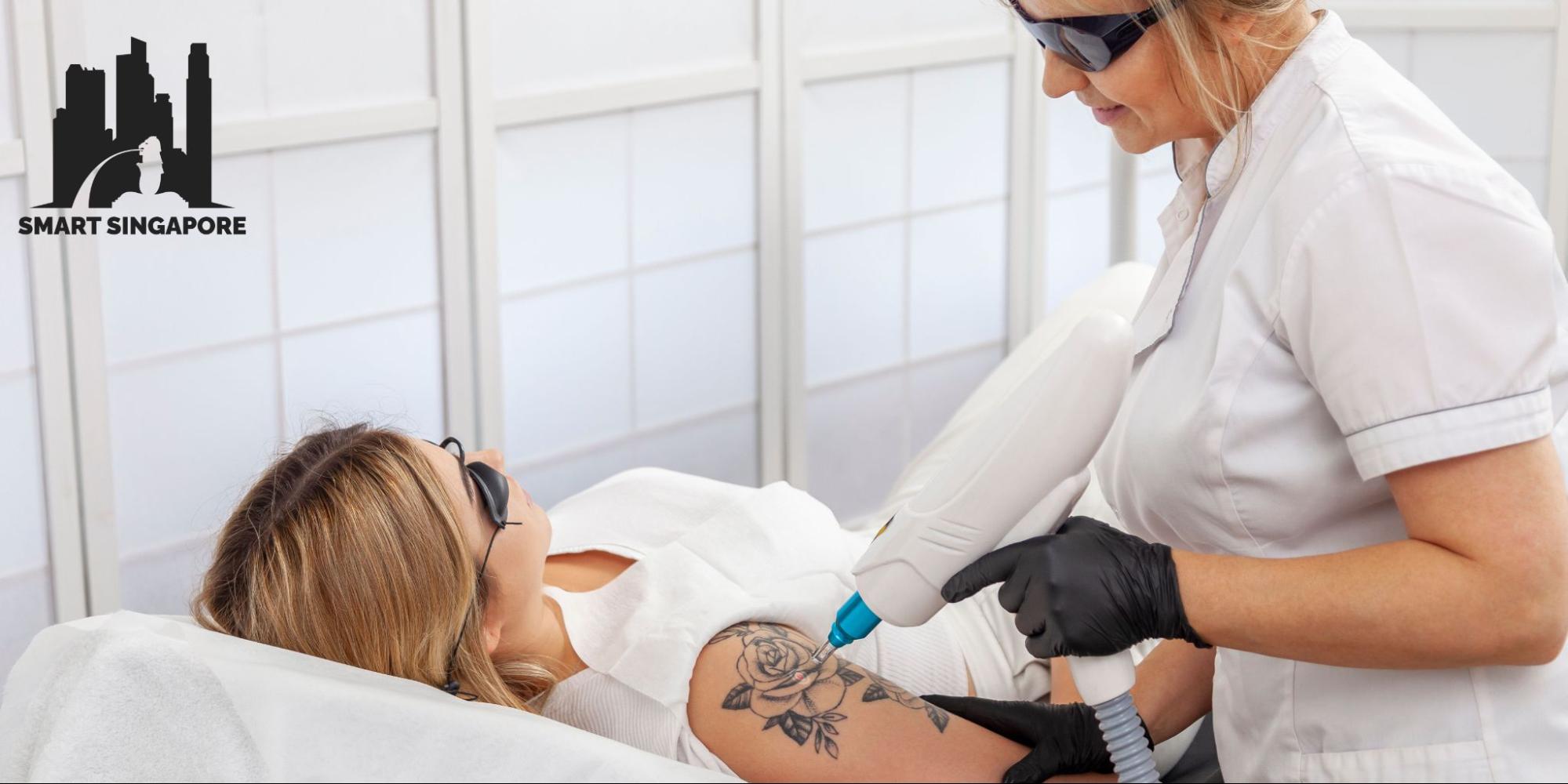
Everything about Tattoo Removal in Singapore
- What is tattoo removal?
- What are the types of tattoo removal in Singapore?
- Q-switch Pico Laser
- Q-switch Nano Laser
- Can I use both the Pico and Nano laser for tattoo removal?
- How is tattoo removal performed?
- Where can I get tattoo removal done in Singapore?
- How much does tattoo removal in Singapore cost?
- What can I expect during tattoo removal in Singapore?
- Skin Assessment
- Preparation
- Tattoo Removal Duration
- What kind of tattoos can be removed?
- How soon after getting a tattoo can I remove it?
- Why should I get a tattoo removed?
- How long does it take to see results after undergoing tattoo removal?
- Why does it take several sessions to remove a tattoo?
- Can tattoo removal permanently remove my old tattoos?
- Can tattoo removal permanently remove body hair?
- Is getting tattoo removal painful?
- What are the side effects of tattoo removal?
- Does tattoo removal leave scars?
- How should I take care of my skin after getting a tattoo removal?
Tattoo removal is widely available in Singapore, but even with the knowledge that tattoos are now reversible, it’s essential to make an informed decision about it.
We’ve compiled all the vital information you need before undergoing tattoo removal in Singapore.
What is tattoo removal?
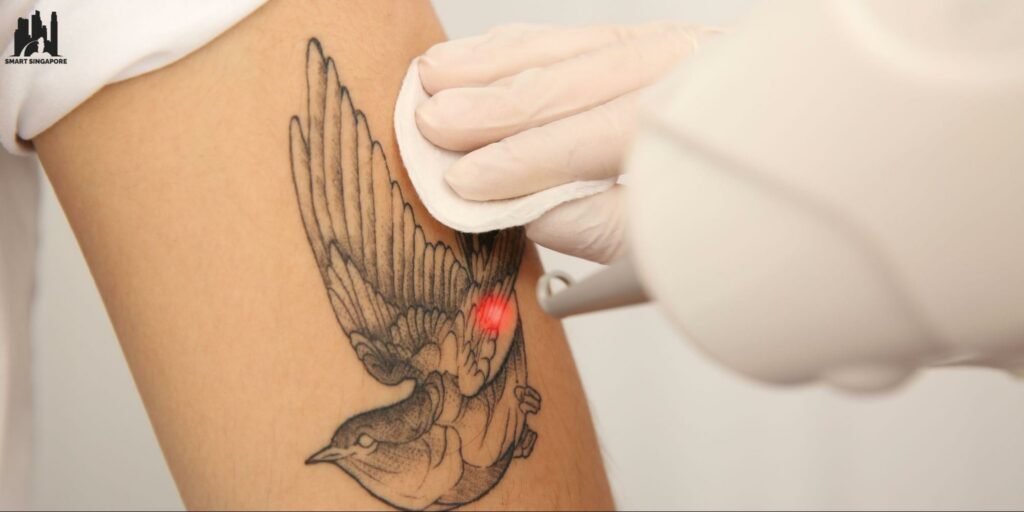
Tattoo removal in Singapore is a procedure that permanently removes ink dyes in the top layer of the skin.
The procedure reverses the indelible effects of tattooing, and laser removal is the most common and arguably the safest method to use.
As you scroll through your options online, you’ll notice that different types of lasers are commonly used in clinics for tattoo removal.
Each type has its own pros and cons, and your chosen dermatologist may advise you on which laser is best for your skin type.
What are the types of tattoo removal in Singapore?
| Q-switch Pico laser | Q-switch Nano laser | |
| Release | Newer generation of lasers | Older generation of lasers |
| Laser speed | Measured in picoseconds (one trillionth of a second) | Measured in nanoseconds (one billionth of a second) |
| Lightening effect | Offers 3x more power, uses shockwaves on small areas | Penetrates deeper skin layers, pulses can cover larger areas |
| Cost | Between $500 and $1,000 per tattoo area | Between $200 and $500 per tattoo area |
| Result efficiency | Best for complete removal of faded tattoos | Best for black or dark tattoo ink |
| Pain level | Less painful | More painful |
There are two main types of laser tattoo removal in Singapore: the Q-switch picosecond (Pico) laser and the Q-switch nanosecond (Nano) laser.
In general, Q-switch lasers are the highest standard when it comes to tattoo removal. They are lauded for the ultra-fast emission of light to reverse pigmentation on the skin.
For tattoo removal in Singapore, the Pico and Nano lasers are commonly used in aesthetic clinics. Skin specialists often choose between the two depending on the needs of their clients.
Before booking an appointment, it’s best to be informed about the benefits of each type of laser. This way, getting the results you want is more efficient.
1. Q-switch Pico Laser
The Pico laser is the latest addition to the family of skin lasers available in the market. The Pico laser is also highly effective in removing tattoos and is considered one of the fastest lasers to emit pulsed light.
Pico lasers are measured in picoseconds, hence the name. It can emit pulsed light within a trillionth of a second! It’s ultra-fast and highly effective in removing small tattoos.
The speed of the Pico laser also contributes to its minimal pain levels. The caveat to this is that the pulsed lights are more efficient in removing ink on small areas.
This leads to slower and longer treatment sessions, which can take several weeks to months. Plus, the longer it takes to remove a tattoo, the more expensive the treatment may be.
Pico laser tattoo removal in Singapore is also relatively pricier than most laser removal types. Many private clinics tend to charge more when clients opt to use the Pico laser.
If you’re willing to pay the extra premium, the Pico laser is an excellent option for tattoo removal in Singapore. It’s highly suitable for clients with faded tattoos.
2. Q-switch Nano Laser
For many years, the Nano laser has been the mother of laser tattoo removal. It is widely considered to be the gold standard for tattoo removal, even with the release of the Pico laser.
The Nano laser emits light pulses in a billionth of a second. Although lightning-fast, it’s slightly slower than the Pico laser but can target larger tattoo areas.
Since this type of laser can target more significant areas, it can fade tattoos faster than the Pico laser. It’s also been around for some time, which makes it highly trusted among skin specialists.
The Nano laser is also FDA-approved. This makes it more available in clinics across Singapore.
Since the Nano laser promotes shorter and faster treatment sessions, it’s a fairly cheaper procedure than the Pico laser.
It’s important to note that the Nano laser can penetrate the skin deeper, which is why it’s highly effective in fading dark tattoo ink.
However, this deeper penetration makes the Nano laser a little more painful than the Pico laser.
If you’re willing to fight the discomfort and need to remove tattoos quicker, the Nano laser is an excellent choice.
Can I use both the Pico and Nano laser for tattoo removal?
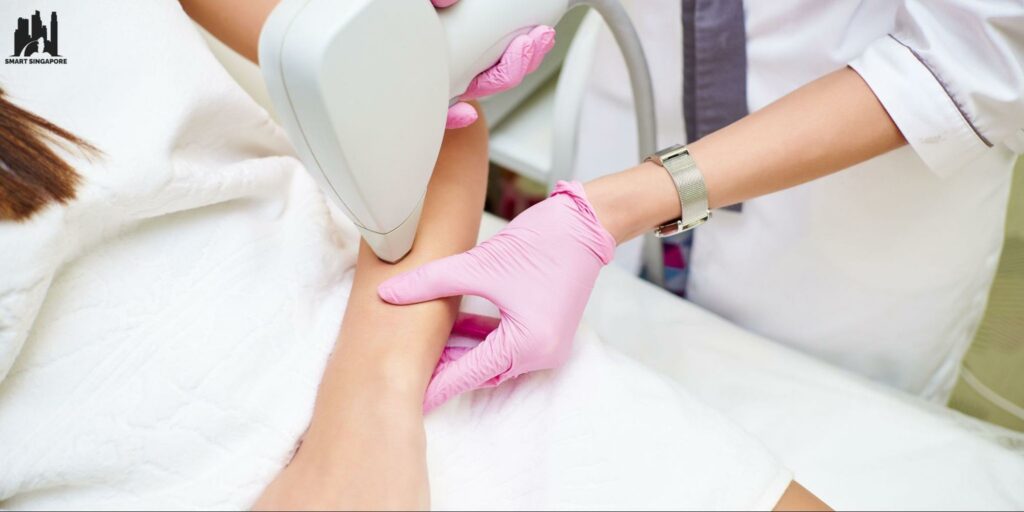
Clinics often incorporate Pico and Nano lasers for effective tattoo removal in Singapore. The Nano laser is first used to fade initial spots during the treatment, followed by the Pico laser to complete the removal process.
It’s best to consult your chosen specialist about using both lasers for single tattoo removal since side effects may be heightened.
How is tattoo removal performed?
To erase tattoos, both Pico and Nano lasers use ultra-fast light pulses to shatter pigmentation on the skin. These pulses penetrate the skin to break up tattoo particles into smaller components.
The body then absorbs these tiny particles, and over time, these are drained by the lymphatic system. The complete fading works just like how the body heals from bruises—it fades after a few weeks.
Where can I get tattoo removal done in Singapore?
Tattoo removal in Singapore is available in aesthetic or dermatology clinics. Clients can undergo the procedure as an outpatient in hospitals, supervised by a medical doctor.
Despite many specialists offering tattoo removal in Singapore, getting it done at a trusted and reputable clinic helmed by medical doctors and skin specialists is still the best.
The lasers can only be handled by professionals who are trained to use them. Don’t settle for less for a cheaper procedure, as it’s better to be safe than sorry.
How much does tattoo removal in Singapore cost?
Laser tattoo removal costs between $500 and $1,500 per session. More complex designs can cost anywhere between $2,000 and $4,000 to fade completely.
The cost of getting tattoo removals in Singapore depends on the type of laser removal you’re availing, the size and characteristics of the tattoo design, and the clinic.
Private clinics have the prerogative to charge a premium for using expensive high-tech equipment, such as lasers.
Tattoo size and characteristics also matter since the bigger and more intricate the designs are, the more sessions it may take to complete the treatment.
Smaller tattoos can cost as little as $50 per session, but clinics may charge you a minimum amount due to the number of sessions required to complete the tattoo removal.
If you need help financing your tattoo removal in Singapore, we highly suggest consulting your financial adviser about the possible effects on your budget.
What can I expect during tattoo removal in Singapore?
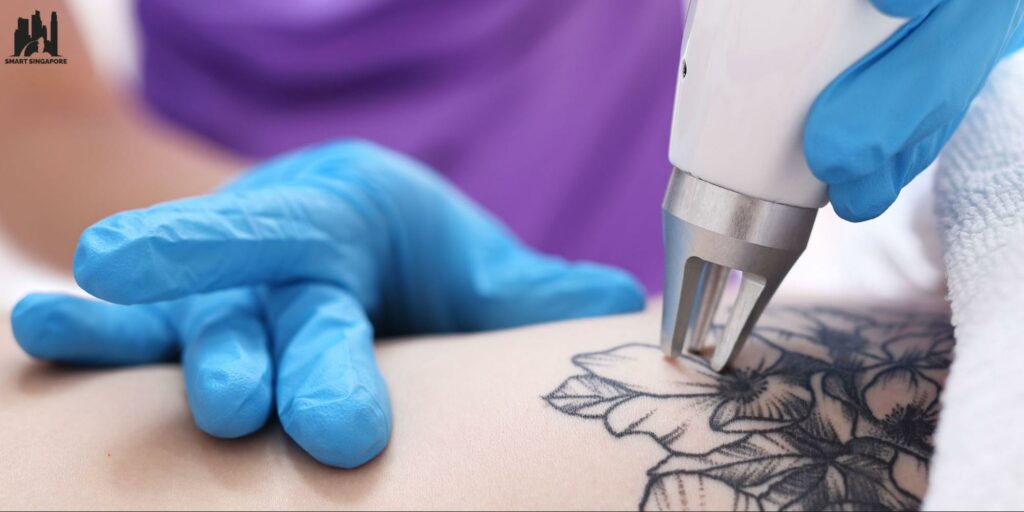
Once you’ve booked an appointment for tattoo removal in Singapore, your chosen specialist will discuss with you the type of procedures they think will suit your skin best.
Skin Assessment
An assessment of your tattoo design and characteristics will then determine your possible expenses for the treatment.
If you have existing scars, your doctor will devise a plan to gently remove pigment without causing further damage to your skin.
The type of laser/s for the procedure will also be finalised according to your budget and time.
Note that tattoo removal takes weeks to complete, and your doctor will inform you of the possible duration of your treatment plan, which affects the cost.
Preparation
Once a plan is agreed upon, your skin specialist will schedule your initial session. During this time, your skin is prepped using disinfectants and numbing cream.
Protective gear, such as goggles, will be provided to protect your eyes from the laser light pulses.
Your specialist will then test the laser frequency on your skin to determine the right amount of energy to emit to remove the pigment effectively.
Tattoo Removal Duration
The tattoo removal session can take a few minutes to an hour, depending on the size and complexity of your tattoo.
Your specialist will then prescribe cooling creams and topical solutions for aftercare before your next session.
What kind of tattoos can be removed?
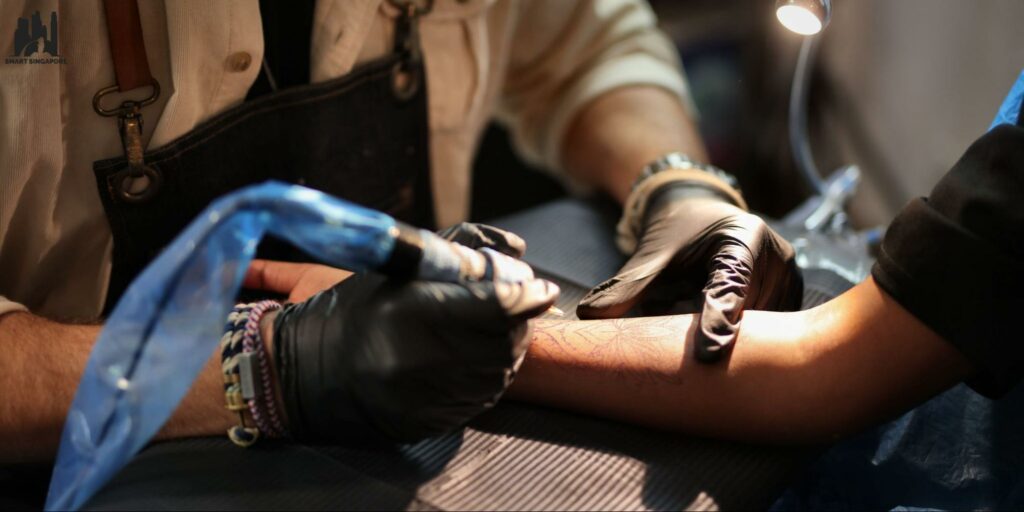
Generally, all types of tattoos are viable for tattoo removal in Singapore. However, some tattoo types are more challenging to remove.
Cosmetic tattoos and designs with colourful and metallic ink are harder to fade and should be removed with caution.
Some ink pigments can only be removed using specific types of lasers. Your specialist will inform you of the best type for these specific areas, which can be used in conjunction with the main laser for complete removal.
How soon after getting a tattoo can I remove it?
You can undergo laser tattoo removal in Singapore after at least two months following getting a tattoo. This is roughly how long it takes for a fresh tattoo to heal.
Tattoo removal is best done on tattoos that no longer scab or swell. This is to prevent further pain during the removal procedure.
Why should I get a tattoo removed?
People undergo tattoo removal for various reasons, and the main one is usually because they regret the design.
You should get a tattoo removed if you’re unhappy with the results of the tattoo artist or if you want to reuse the space for a completely new design instead.
Rather than revamping an old design, you can always start fresh once your skin has healed from the tattoo removal procedure. It’ll take time, but we believe it’s worth it!
How long does it take to see results after undergoing tattoo removal?
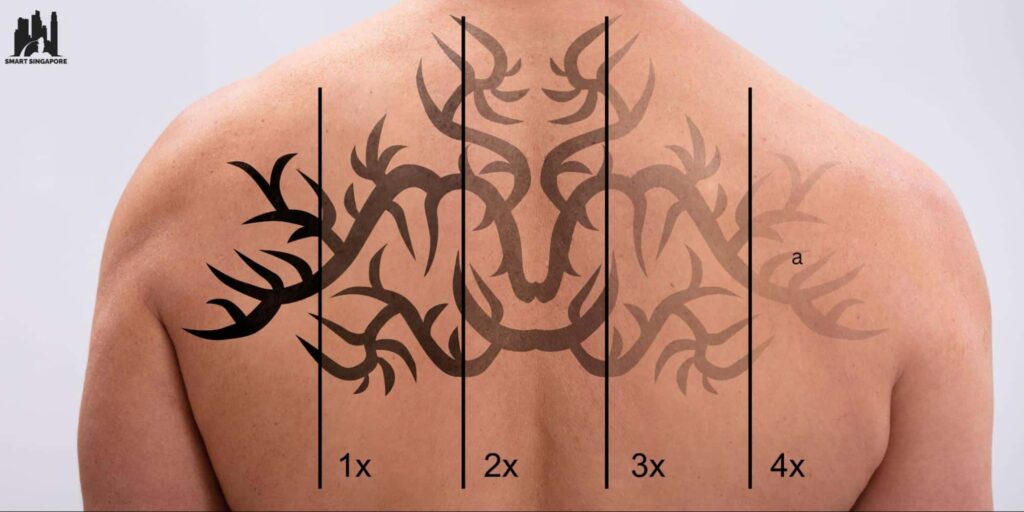
On average, it takes about 10 sessions for a tattoo to fade completely after undergoing tattoo removal. You may start to see your tattoo fade by your third or fourth session.
Since it takes at least a few weeks between each session, complete removal can take several months to finish.
The time spacing is essential in ensuring the best possible results. This gives your skin time to heal in between sessions.
The treatment duration will depend on your tattoo’s pigment, size, and design. Once you’ve undergone at least three sessions, you’ll begin to see significant changes.
Why does it take several sessions to remove a tattoo?
It takes several sessions to remove a tattoo because tattoo artists typically apply pigments in layers.
Ink may be inserted deeper, leading to more sessions to break them apart without causing damage to your natural skin barriers.
Laser removal is also quite exhaustive to your skin. It takes time for your skin to heal from the ultra-fast light beams. This is the proven and safest way to remove a tattoo.
Can tattoo removal permanently remove my old tattoos?
Laser tattoo removal is highly effective in removing old tattoos permanently. Despite its long duration, using laser removal is the safest and most efficient method of tattoo removal.
However, take note that some pigments, like colourful and metallic inks, may resist laser removal. Pigments that reach deeper layers of the skin may take longer to fade completely.
It’s important to inform your doctor about your tattoo experience and give them the opportunity to inspect the tattoo completely.
Your doctor can recommend specific lasers for safe and proper removal.
Can tattoo removal permanently remove body hair?
Tattoo removal can’t remove body hair permanently. Laser therapy is also used for permanent hair removal, but it’s different from the type of laser therapy used for tattoo removal.
In the tattoo removal procedure, the light pulses penetrate pigments under the skin. For permanent hair loss to occur, the laser should target breaking down hair follicles instead.
This doesn’t happen during tattoo removal due to the ultra-fast pulses.
Rarely, minimal hair loss may occur at the targeted tattoo removal site. While hair is lost, it grows back since the follicles are still intact.
Is getting tattoo removal painful?
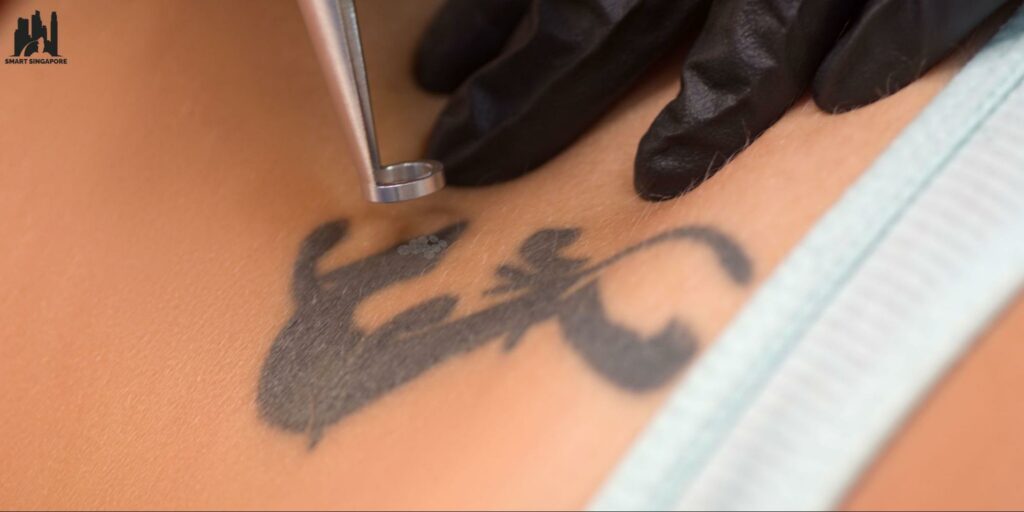
Tattoo removal is painful but absolutely tolerable. Pain levels will depend on the client’s pain tolerance and preferred laser type used during the procedure.
Pico lasers are less painful than Nano lasers but are effective on small, faded tattoos. If your tattoos are heavy in pigment and design, your specialist might suggest using the Nano laser instead.
Although slightly painful, both types of tattoo removal in Singapore are tolerable, and any discomfort fades as quickly as the light pulses.
The pain is described as the same sensation as getting hit by a rubber band. It’s swift, and clients with high pain tolerances may not feel that much discomfort during the procedure.
If you’ve endured the pain of getting inked, it’s likely that you’ll be able to endure the same amount of pain, or even less, during tattoo removal in Singapore.
What are the side effects of tattoo removal?
Common side effects of tattoo removal include swelling, blistering, redness, and, rarely, scarring.
These side effects usually go away over time. However, more serious side effects like infection and discolouration should be brought to your doctor’s attention.
While lightness on the targeted tattoo areas is normal, if you start noticing that the pigmentation does not go away, it may be a sign of a more serious side effect.
Blistering is also common but should be monitored with caution. Since your skin is exposed to laser light beams, its barrier is vulnerable to environmental factors.
Blisters should be regularly cleaned and checked. If they grow painful and bigger over time, consult your doctor about possible remedies.
Infections are rare but also possible if you don’t properly take care of your tattoo area in between sessions.
It’s important to consult your doctor about any prolonged side effects before trying out home remedies to lessen any pain or discomfort.
You wouldn’t want to hinder the fading progression, especially when you’re almost done with the treatment. Leaving any serious side effect untreated could lead to health complications.
Does tattoo removal leave scars?
Scarring is a rare side effect of tattoo removal that usually occurs when a client doesn’t treat the treatment areas properly during aftercare.
For example, if you scratch the targeted areas, you’re increasing the chances of scarring by harming the delicate skin barriers.
How should I take care of my skin after getting a tattoo removal?

You should always follow your doctor’s recommended aftercare routine in between and after your tattoo removal sessions.
Always cleanse the treated area regularly, specifically twice a day, with mild soap. To reduce friction, you can apply petroleum jelly on the area and wear loose clothing.
If your treatment area is constantly exposed to the sun, always apply sunscreen whenever you head out.
Sun exposure can worsen side effects and lead to more damage to your skin. Apply a minimum of 50 SPF on the targeted area and reapply throughout the day.
If your skin is sensitive and prone to swelling and infection, keep the area covered with gauze and change the dressing regularly throughout the day.
This is to protect your skin against sun damage and external particles that may cause irritation when in contact with your skin.
It’s also important to avoid touching the treatment area. Always handle your skin with care and do so with clean hands.





